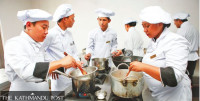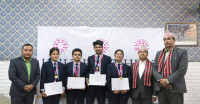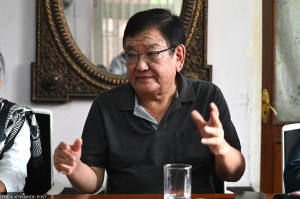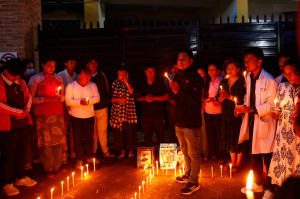Miscellaneous
Catching dreams in Kathmandu
Thamel Handicraft appears to look like the many other curio and handicraft shops that pepper the touristic district of Thamel.
Samikshya Bhattarai
Thamel Handicraft appears to look like the many other curio and handicraft shops that pepper the touristic district of Thamel. At the counter, Rajeev Ojha—a middle-aged man who has been in the business for the past twenty years—is twiddling with this phone. Occasionally, when a tourist who looks like they will make a big purchase steps in, Ojha perks up and begins showing them around. Decked on the walls are hemp bags and purses, key rings, post cards, prayer flags and other knickknacks advertised as great authentic takeaway gifts from Nepal. But hanging amid all the Nepali handiwork is a foreign object. Dream catchers of all assorted sizes and dimensions are now selling like hotcakes from the store.
“We started selling dream catchers four years ago, but the sales have really picked up in the last couple years. Local youngsters have unexpectedly become important customers for us,” says Ojha.
Dream catcher originated from the Ojibwa people from the American mid-west. Round in shape, with assorted feathers hanging from a frame that is criss-crossed with strings, the dream catcher is one of the chief mainstream handicraft exports of the Native Americans in the US. Traditionally made to ward off bad dreams, dream catchers are placed over the cribs of new-born children to ensure that they are not haunted by nightmares, which the Ojibwa believe can hamper their growth. It is believed that while good dreams easily pass through the nets of a dream catcher, they prevent bad dreams from seeping through. In the turn of the century, as Native Americans began to spread away from their reservations for work and studies in big American cities, parents began gifting children with dream catchers as a good luck charm, further proliferating their use and popularity in American culture.
But what is a Native American artifact doing in Kathmandu?
“The first ever dream catcher we produced was modeled after a piece we brought from Indonesia,” says Ojha, “But now the business is booming.” According to him, the popularity of dream catchers caught on with young Nepalis following its prominence and repeated display in the Korean drama series Heirs. Heirs, a high-school TV series, played up the dream catcher as a symbol of hope for the main leads, separated by familial friction. “Soon thereafter, their popularity soared throughout Asia.”
“We started by copying the Indonesian sample but one thing led to another and we were soon producing nearly 100,000 dream catchers a year,” says Ojha. “Now everybody seems to know what this obscure artifact is. We have even started exporting dream catchers to America, the place of its origin, which is mind-boggling at so many levels.”
Thamel Handicrafts in fact has a factory that churns out dream catchers by the bulk. Located in Banasthali, the factory today employs around 500 workers who produce bags, prayer flags, and other curio items. The factory also has a dedicated staff of 50 who work just on dream catchers.
According to Amrit Rai, a political advisor at the Korean Embassy in Nepal, the dream catcher is one of the many exports that popular Korean dramas have brought to Asia, and the world. “Yes, it is amazing to see how popular and widely-followed Korean TV series and movies have become. And to think that the popularity of dream catchers in Kathmandu started from a Korean drama is really heart-warming. KBS (Korean Broadcasting System) and Arirang are very popular in the region and boast large audiences.”
Rai points to the popularity of Korean fashion trends as another example of how popular Korean entertainment is in Asia. “You can see the huge influence of Korean fashion trends in young people today, not just in the Valley but outside as well. Our Korean cultural events at the embassy always command a big turnout as well.”
But beyond being just a cultural import, Ojha confirms that dream catchers have taken a life of their own in the Valley—seamlessly blending in with other Nepali handicrafts at stores. So much so, dream catchers have in fact been modified by Nepali manufacturers to give them a local flavour. “Traditionally, dream catchers are made with muted colours, but we are making them in bright hues instead,” says Ojha.
Rajan Basnet, another handicraft store operator in Thamel, adds that instead of just the criss-crossed netting, Nepali manufacturers have been experimenting with other variations including flowers, stars and moons to make them more appealing to local customers. “We have heard that dream catchers are usually dark and decorated with feathers from eagles. But here, we use dyed chicken feathers, very bright colours and beads used in other Nepali handicrafts. Even American tourists familiar with dream catchers usually prefer the colourful ‘Nepali’ variation,” he says.
Back at Thamel Handicrafts, Pragya Khanal, a 17-year-old student, is scoping out a dream catcher for a gift for a friend’s birthday. “My friend is absolutely obsessed with Heirs. She will be over the moon with this gift. And because it is cheap but glamorous, it doesn’t make too big a dent on my pocket either,” she says.
According to Ojha, the store sells anywhere from 10-200 pieces of dream catchers a day. And the trend does not seem like it will stop anytime soon. “We stumbled on the dream catchers by accident, but now we have been able to convert it into a thriving business. It goes on to show how small a world we live in today; and that there is a market out there not only for Nepali handicrafts, but for handiwork from around the world.”




 22.12°C Kathmandu
22.12°C Kathmandu










